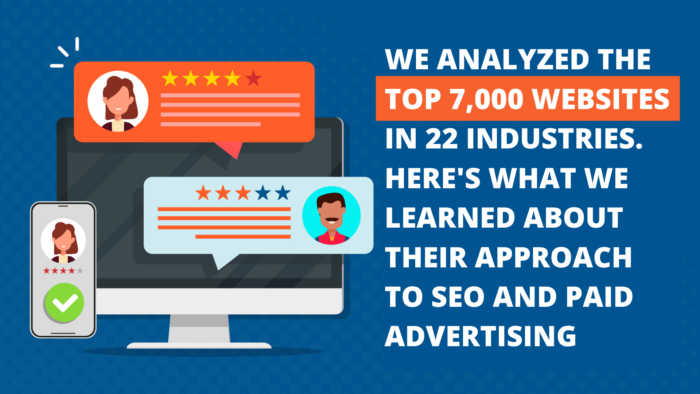
We analyzed more than 7,000 company websites across 22 industries to answer one question: what was their approach to SEO and paid advertising to help them do so well?
In this analysis, we only looked at companies that ranked well and had at least a 4-star review or higher. These businesses aren’t just liked by Google, they’re also liked by customers.
Where’s the Data From?
We used the consumer review website TrustPilot to select the 7,000+ websites with a review rating of 4-stars or more and then cross-referenced this data with Ubersuggest to see which were liked by both users and Google.
Through Ubersuggest, we learned more about their approach to SEO, traffic factors, backlinks, and more which you will see in the visualizations below.
What Industries Did We Look At?
The 22 industries analyzed in this report were:
- Education and Training
- Public & Local Services
- Home Services
- Animal & Pets
- Vehicles & Transportation
- Media & Publishing
- Sports
- Hobbies & Crafts
- Events & Entertainment
- Restaurants & Bars
- Travel & Vacation
- Shopping & Fashion
- Electronics & Technology
- Food, Beverages & Tobacco
- Home & Garden
- Business Services
- Money & Insurance
- Legal Services & Government
- Health & Medical
- Construction and Manufacturing
- Beauty & Well-being
- Utilities
Key Findings
There is no one-size-fits-all approach to digital marketing. Black and white advice doesn’t work for every company.
You will need to take a different approach depending on the audience in your industry. That is why we included a wide range of industries in our analysis instead of just making blanket statements.
Here are a few key insights we found:
- Companies in all industries get more organic traffic than paid traffic. However, Restaurants & Bars and Travel & Vacation received more paid traffic compared to other industries.
- The average website authority score was between 30 and 40 for the companies in each industry analyzed. Some industries, such as Utilities and Animals & Pets, were lower than average.
- Public & Local Services face the highest average keyword difficulty for target terms. Beauty & Well-Being faced the lowest average difficulty for target keywords.
- More than 75% of total backlinks across all industries were text backlinks.
- Companies in all industries targeted more informational intent keywords, however traffic volume was driven by a mix of different intent keywords.
Analysis #1 – Organic Search Traffic vs Paid Search Traffic Volume
Does most of your traffic come from paid ads or organic search? We looked at the difference in volume between organic search traffic (traffic driven from search engines like Google) and paid traffic (traffic driven to your site via paid ads.)
These trends highlight where industry leaders are focusing their marketing efforts—and whether those results are paying off. We found several interesting trends in this data.
NOTE: the numbers below represent the average organic and paid traffic per company website, not a total of all traffic in that industry.
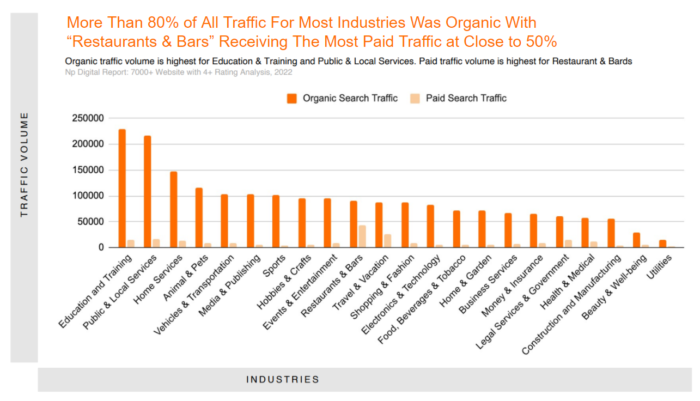
Public & Local Services received 216,861 visits from organic search and only 16,931 from paid search, less than 10 percent of total traffic. Public services, like a power company, are unlikely to use paid ads since people will generally just choose one of the few services offered in their area.
Focusing on SEO can benefit these companies more. That said, the low competition for paid ads could represent an opportunity to boost their presence.
Companies focused on Education and Training received the most organic searches at 230,075 visits per month. These companies should focus more on SEO and content marketing but also keep an eye on how to leverage paid ads since competition is low.
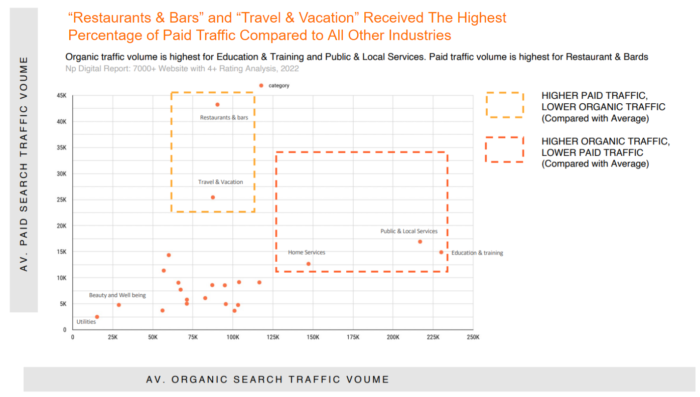
Restaurant & Bars sites, on the other hand, rely more heavily on paid traffic compared to all industries with almost 50% coming from paid ads.
People searching in this category are probably looking for somewhere to go soon so using paid ads to increase conversions makes sense.
Travel & Vacation sites also rely on paid ads that results in close to 30 percent of their traffic. Organic traffic is still higher but it looks like companies also boost their offerings through paid ads.
If you are new to the sector, focus on increasing organic traffic right away as it will take longer to see results. Paid ads are effective as well, but they can be expensive.
Shopping & Fashion only got a bit less than 10 percent of traffic from paid ads. This could mean companies focus more on social sharing and social media ads since a lot of content is visual.
The Sports industry received the least traffic from paid ads at under 4 percent. This was interesting since the industry includes a lot of ecommerce brands that sell sports gear, outdoor apparel, sports drinks, and team apparel.
This could indicate a trend towards more social sharing and social media ads as well. It could also mean impulse purchases are less common since customers are more likely do their research. Therefore, creating educational content might be the way to go.
Analysis #2 – Trends Related To Authority Score, Keyword Difficulty, and Average CPC
How does domain authority vary across industries? Does it correlate with how much you’ll pay for ads? Does keyword difficulty have an effect? We dug into this data to see trends for each industry.
Authority Score measures your website’s Domain Authority which also influences rankings. It grades the overall website quality based on the number of backlinks, referring domains, outbound links, etc.
Authority Score is also relative to your industry.
Average Authority Scores Across All Industries
This first chart shows the average website authority score for businesses in each industry.
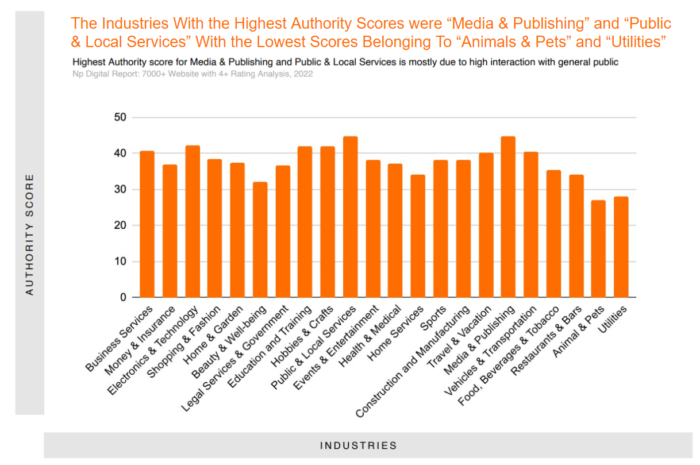
The average authority score was between 30-40 for business websites in each industry.
Hundreds of business sites were looked at in each industry with a mix of higher and lower authority scores, resulting in the numbers above.
Media & Publishing had the highest average authority score of 44.62 followed very closely by Public & Local Services at 44.61. Business sites in each sector are usually more trusted sources so this makes sense.
On the flip side, the lowest authority score industries were Utilities at 28.09 and Animals & Pets at 27.08. A lot of factors could have led to this such as many new sites created in each industry.
There was close to a 20 point variation in authority scores across all industries in this analysis with the median score being 38.06.
- Websites between 40-50 are considered average
- Websites between 50-60 are considered good
- Websites above 60 are considered excellent
What does this mean for business websites and marketers?
This analysis looked at companies with high review ratings which means they placed a lot of emphasis on reputation management, maybe more so than SEO factors.
We can see that a business’s authority score didn’t really impact whether or not they got a high review rating. People-focused more on reviewing products and services than the business itself.
Average SEO Keyword Difficulty Across All Industries
Next, we looked at the average keyword difficulty for terms in each industry. Most content creators target keywords with low difficulty and high volume which is easier for some industries than others.
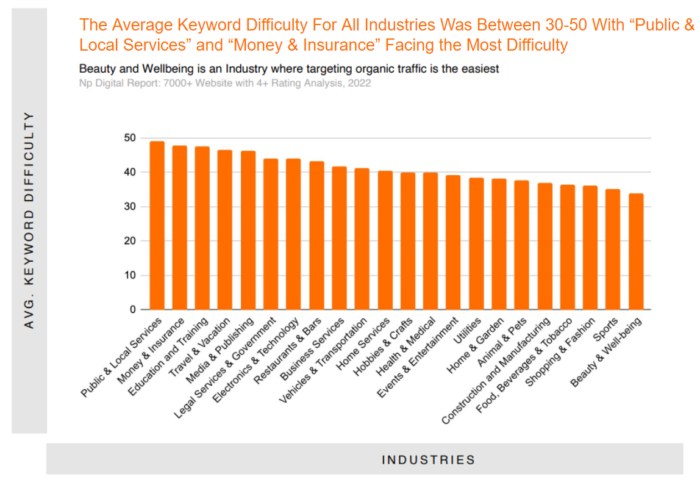
Industries with the highest difficulty were Public & Local Services at 49.02, Money & Insurance at 47.72, and Education and Training at 47.62.
To improve their search rankings, these industries will likely need to spend more time on their SEO strategy or invest more heavily in paid ads.
Industries with the lowest difficulty were Shopping & Fashion at 36.26, Sports at 35.12, and Beauty & Well-being at 33.75. It will be easier for these industries to find keywords to rank for.
Across all industries, the average keyword difficulty for SEO is 41.
What does this mean in practice? Relativity matters when looking for low-difficulty keywords.
For example, say you’re a business in the Money & Insurance industry and find two terms you’re not ranking for. One has a keyword difficulty of 45 with a search volume of 12,000, the other has a keyword difficulty of 40 with a search volume of just 6,000.
Understanding that 45 is below the average difficulty in your industry, targeting the higher volume term might not be a bad idea. You could also target related keywords as well and use paid ads to boost some of the more difficult ones to expand your reach.
For industries with low average keyword difficulty like Beauty & Well-being, target easy-to-rank-for terms to increase traffic, then use CRO strategies to leverage that traffic.
Average CPC (Cost-Per-Click) Across All Industries
The final graph of this section looks at the average CPC for each industry. We were curious to see if any correlation existed with the average authority score of company websites. Here’s what we found:
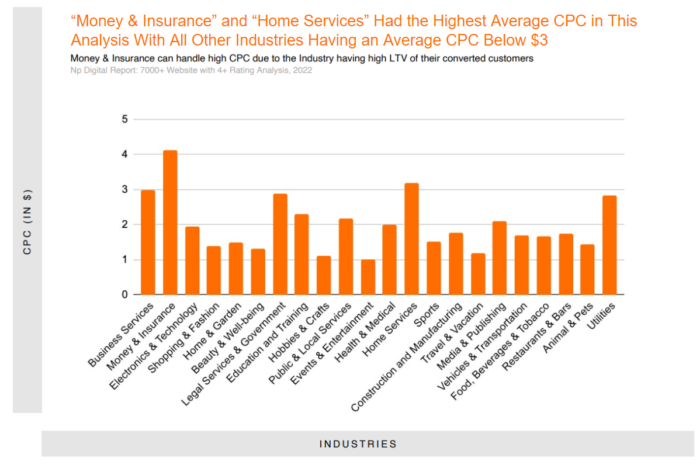
Very little correlation between the industry’s average authority score and their average CPC was found.
One factor affecting this might be the difference in acquisition costs and purchase value.
For example, a site selling $20 t-shirts won’t spend $10 per customer but an investment site whose average purchase price is more than $100 might.
In this analysis, Money & Insurance has the highest average CPC at $4.12.
Businesses in this industry might be willing to spend more on average for each click since the lifetime value (LTV) of each customer is much higher.
Hobbies & Crafts has the lowest average CPC of $1.12 across all industries.
They only receive about 5 percent of traffic from paid ads which could indicate that businesses focus more on social channels where many craft/hobbyist groups and influencers exist.
Home Services has a higher average CPC at $3.17. Business sites in this industry include plumbers, lawn care work, etc. Increased competition for local customers has likely led to the higher average CPC.
Shopping & Fashion had one of the lowest average CPC’s at $1.40.
This could be another indication that businesses promote their visual content more on social media. However, the low average CPC could represent an opportunity to get creative with paid ads.
Analysis #3 – Average Number of Backlinks Per Industry and Their Most Popular Formats
Backlinks matter—that’s nothing new. What about the format of those backlinks? Is a text backlink better than an image backlink? How many backlinks is enough?
That’s what we aimed to find out.
Average Number of Backlinks Per Industry
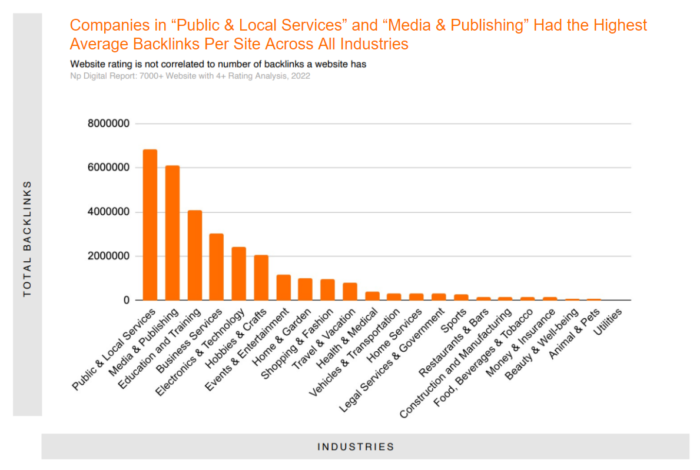
The average number of backlinks varies quite a bit by industry with the most belonging to:
- Public & Local Services at just over 6.5 million per site
- Media & Publishing at just over 6 million per site
- Education and Training at just over 4 million per site
These industries include more trustworthy business sites such as essential local services, news outlets, media publications, universities, certification platforms, and more.
The lowest average backlinks belonged to Beauty & Well-being, Animals & Pets, and Utilities. This could indicate each sector focuses more on social media or they have a lot of new business sites.
Money & Insurance coming in very low was surprising to me. I would have expected the industry to average at least as many backlinks as Shopping & Fashion at just under 1 million per site.
Distribution of Backlinks by Format
We also looked at the distribution of backlink types across each industry to see which performed best. The two backlink types that stood out were:
- text backlinks
- image backlinks
NOTE: the graphs below represent the total number of backlinks for each industry, not the average for each company website.
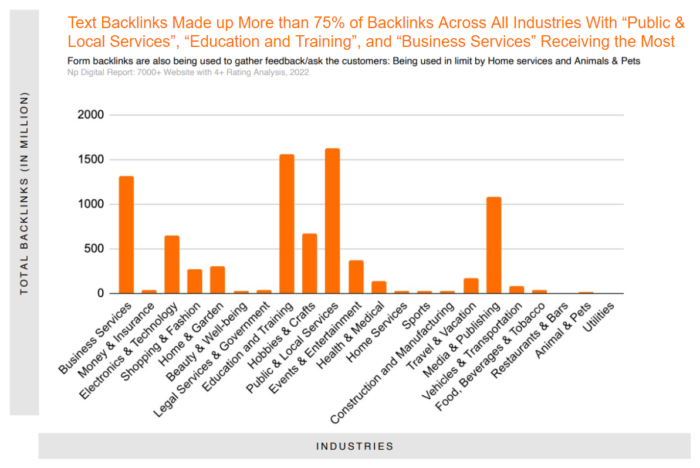
Text backlinks were the most popular across all industries:
- Public & Local Services received the most at just over 1.6 billion
- Education and Training was next at just over 1.5 billion
- Business Services followed at just over 1.3 billion
- Media & Publishing was the last with just over 1 billion
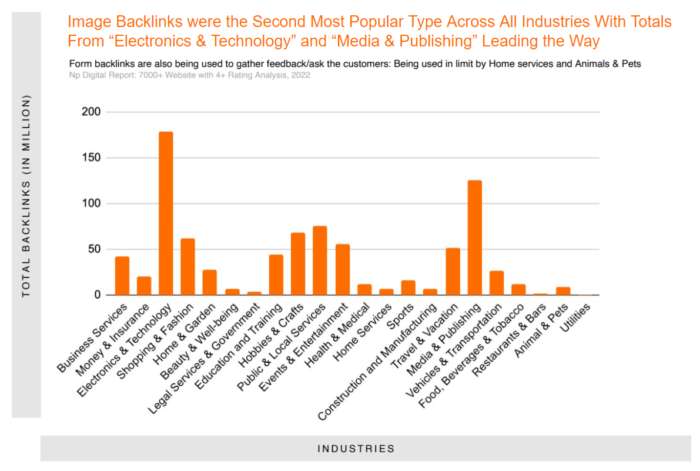
Image backlinks were the second most popular type. The two industries that used them the most were:
- Electronics & Technology at close to 180 million
- Media & Publishing at just over 100 million
The two other types of backlinks used were form and frame backlinks. However, both combined made up less than 5 percent of total backlinks across all business sites in this analysis.
What does this mean?
Text backlinks are the most popular for driving traffic across all industries but some industries will also rely just as much on image backlinks.
You should mix up your approach, leveraging different backlink types to reach different audiences.
Analysis #4 – Target Keyword Intent and the Intent That Led to the Most Traffic
Lastly, we looked at target keyword SEO intent in each industry based on the following categories:
- Commercial intent keywords: related to specific brands or services (“find a Starbucks near me”)
- Informational intent keywords: searching for answers to questions (“How to unclog a tub”)
- Navigational intent keywords: users looking for specific pages (“Comcast login page”)
- Transactional intent keywords: users are ready to buy (“buy converse shoes”)
Looking at different keyword intents when choosing target terms can highlight trends and opportunities in your industry.
So, what did we learn?
NOTE: The first chart indicates the keyword intent of target terms in each industry. The bottom chart shows which intent type resulted in traffic to each business site.
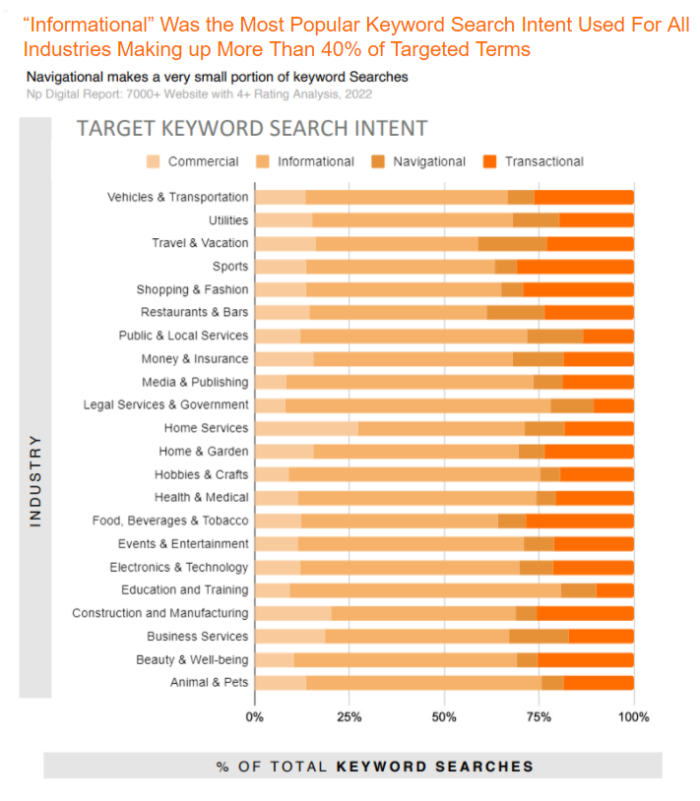
The most popular keyword intent was informational at more than 40 percent of target terms in all industries.
These are generally top-of-the-funnel keywords, meaning users are still early on in their journey.
The next highest intent type was transactional at between 15-20 percent of terms per industry.
These users are ready to buy so creating content that targets these terms or using paid ads is a good idea.
Next, we looked at which intent keywords drove the most traffic to company sites in each industry.
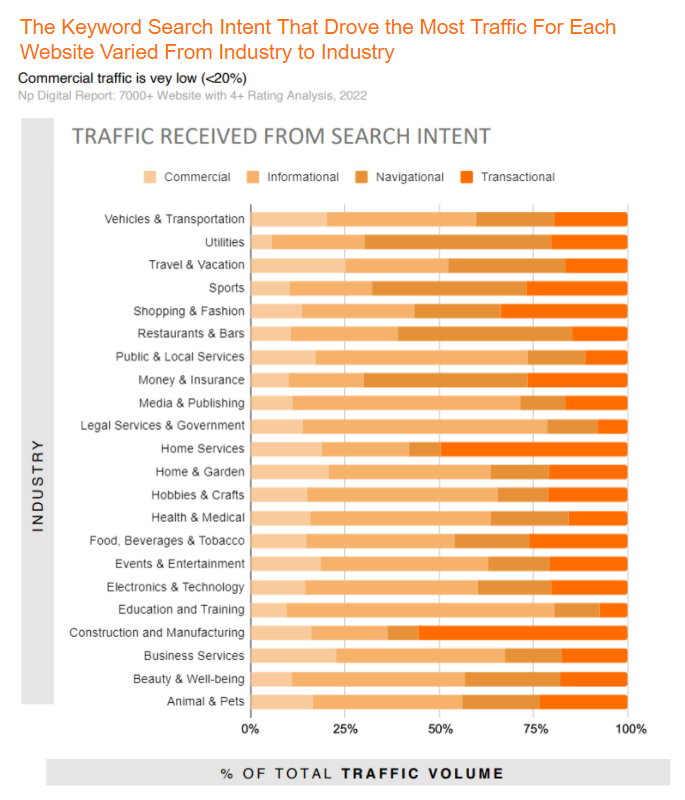
Like most industries, Utilities sites mostly target informational keywords. However, most of their traffic comes from navigational terms which relate more to specific pages and their brand name.
This is likely due to search behavior, rather than incorrect targeting practices.
For example, if someone wanted to pay a power bill, they might type “pay bill X” in Google to find the right page. You wouldn’t target this term directly but it does bring traffic to your site. Focusing on informational keywords that establish trust is still the right approach.
Similarly, Money & Insurance websites focus on informational terms but get most of their traffic from navigational terms.
This could be a combination of good branding as well as similar user search behavior patterns. Usually, for your navigational terms to be successful, users will have read your informational content before deciding you were the right fit for them.
On a different note, Construction & Manufacturing businesses target informational keywords but also target transactional keywords at a higher rate than other industries. Clearly, this strategy works as most of their traffic comes from transactional terms.
Lastly, Home Services target more commercial intent keywords than other industries. These are likely terms more focused on a particular location using phrases such as “near me” or “in [city]”.
However, we can see that just under 50 percent of their traffic comes from transactional terms. This means they might want to adjust their focus to include those terms along with their commercial approach.
Keep in mind that just because your website receives traffic doesn’t mean it is all converting. Make sure your traffic is directed right pages on your site and each page is optimized for conversions.
Conclusion: Summary of Findings
There were a few surprises in this data—and a few things that turned out exactly as we expected.
For example, backlinks matter. Google has been telling us that for years, so I wasn’t surprised to see the highest-reviewed business websites tend to have a pretty high volume of links.
What was surprising was the variation in the types of backlinks between different industries. This data can be incredibly valuable for sites looking to build a more effective backlink profile.
I was also interested in the differences between the types of keyword intent most sites target for SEO (primarily informational) versus where they are getting their traffic from. Depending on your industry, this data could highlight incredible marketing opportunities or gaps in your current strategy.
Which finding was most interesting or useful to you?
from Blog – Neil Patel https://ift.tt/zt3v9uw0W

No comments:
Post a Comment